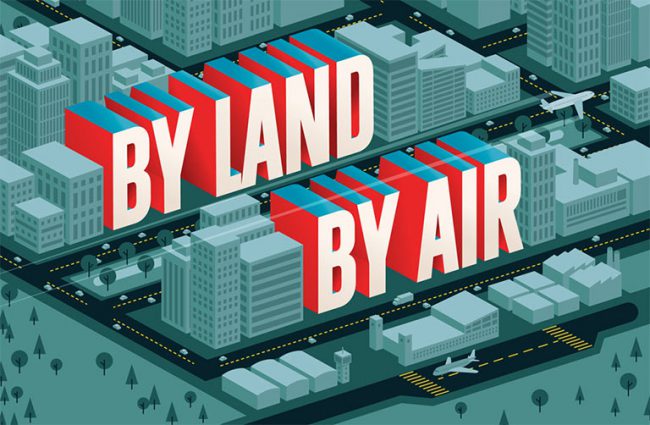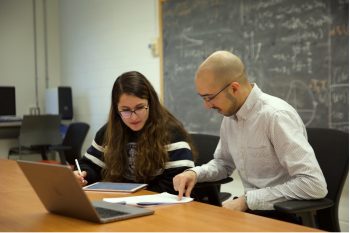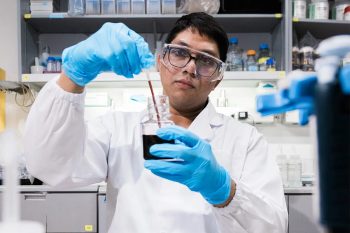People used to say that the journey was as important as the destination. But that was back when travel was exotic and exciting—before voyagers were so infuriated by gridlock, so concerned about safety and so consumed with their carbon footprint that the journey became something to endure, rather than savour. It doesn’t have to be this way.
Researchers from U of T Engineering are collaborating with leading industry and government partners on projects that aim to ease travel worries, minimize delays and reduce our impact on the environment.
Click on the icons below to explore three of these promising projects, originally shared in the 2014 issue of Skulematters.
Simulation city: solutions for a better urban commute
Transit planning for large urban centres doesn’t always involve simulations. But for those interested in evidence- based transit strategies, simulations have become so sophisticated and detailed that they can map commuter behaviour right down to the individual level.
“I’m interested in understanding and modelling travel behaviour,” said Eric Miller (CivE), civil engineering professor and director of the University of Toronto Transportation Research Institute (UTTRI). “I try to simulate the city itself—how the population is changing in terms of the labour market, housing market, demographics and so on. It’s SimCity for real.”
Through UTTRI’s Travel Modelling Group, Miller works with city and municipal governments, Ontario’s Ministry of Transportation and regional transit organizations such as Metrolinx.
The group has developed innovations like MARLIN, Professor Baher Abdulhai’s (CivE) “smart traffic light program” that dynamically reacts to local traffic flow, reducing commute times.
Miller’s simulations embody a level of complexity and granularity that was unimaginable even a decade ago.
“We’re building ‘agent-based micro-simulation models,’” he said. “We create a synthetic population: if there are six-and-a-half-million people in the Greater Toronto and Hamilton area, we model every one of these people and say, ‘What are you going to do today?’”
Ministries and municipalities use Miller’s models to run simulations that inform policy decisions. But he thinks his group could contribute more on the policy front.
“We don’t see the agencies necessarily doing as much as they could to ask ‘What if…’ questions and dig deeply into the possibilities,” he said, stating that his data provide insight into not only transportation policy, but also the population itself.
“We’ve found through these agent-based models that people are more often than not to act fairly rationally,” he said. “From a policy point of view, it’s encouraging to know that if you do provide people with a better alternative, they will respond to it.”
How’s my driving? Never mind—I’ll ask my car
A research-intensive company—say, an automobile manufacturer—tends to keep discoveries secret. It maximizes their competitive advantage. A university researcher, on the other hand, circulates knowledge widely for the benefit of the public.
Which might be why Birsen Donmez (MIE), industrial engineering professor and driver-safety researcher, still seems so surprised and delighted, two years through her three-year collaboration with Toyota.
“A few years ago, Toyota allocated a chunk of money to support safety research in North America,” said Donmez. “They said, ‘This doesn’t have to be confidential research. We just want to support the study of important problems related to traffic safety.’”
Donmez proposed a single experiment related to speeding and tailgating behaviours, which Toyota requested she expand into a multi-year program, involving a combination of driver-simulation studies and analysis of crash data.
“Toyota wanted us to tell them how to provide feedback technologies that would benefit drivers without distracting them,” she said.
Donmez and her team are working on both immediate warnings and post-drive “report cards” that assess a driver’s overall performance.
“We can follow people’s eye movements in real time and if they take their eyes off the road for longer than two seconds, we can tell,” she said. But they’ve found they must be selective about instantaneous warnings, as too many beeps or lights become a distraction unto themselves.
A report card can be much more detailed—documenting risky behaviour, and putting it in the context of both the driver’s individual history and also general norms and best practices.
Donmez said the report card is likely most effective for new drivers, who are just establishing their road habits, but that it also has potential benefits for aging drivers.
“Older people who are losing some of their abilities tend to self-regulate,” she said. For instance, some people give up highway trips or driving at night when they realize it’s no longer safe. “Maybe we can help them regulate better.”
How do I leave a footprint when I’m not touching the ground?
Jets, once the epitome of exotic travel, now face a hard truth: lifting a crowd of people into the sky and carrying them a long distance requires a large amount of energy. High fuel consumption and carbon footprints, in part, can temper the thrill of takeoff, burdening it with ecological guilt.
“The environmental impact of aviation is quite broad,” said David Zingg (UTIAS), professor and director of the University of Toronto Institute for Aerospace Studies (UTIAS). “In addition to flights themselves, there is airport operation, as well as manufacturing and disposal of aircraft.”
Researchers from UTIAS’s Centre for Research in Sustainable Aviation attack issues like greenhouse emissions on many fronts, from improving aircraft design to developing climate-friendly biofuels. They also work with industry partners like Bombardier and Pratt & Whitney to ensure their work is grounded in the real-life concerns of the aerospace industry.
Zingg’s background in computational fluid dynamics means he focuses on innovative aircraft designs that reduce drag. He spent three years working with Bombardier on airplanes that barely resemble conventional “tube-and-wing” models. With names like “box-wing” and “blended wing-body,” his designs optimize airflow and reduce fuel consumption and greenhouse gases.
“I benefited more from this collaboration than from any I’ve ever done,” said Zingg. “[Bombardier] gave us funding to advance our algorithms, but they also gave us the opportunity to apply them, which is when you really learn whether your methodology is effective in the real world.”
The partnership with Bombardier has helped shape Zingg’s next avenue of research—a “truss-braced wing” design that may lead to a new generation of environmentally friendly jets.
“Truss-braced wing models might be the most promising designs for certain classes of aircraft in the next 15 years,” he said.



